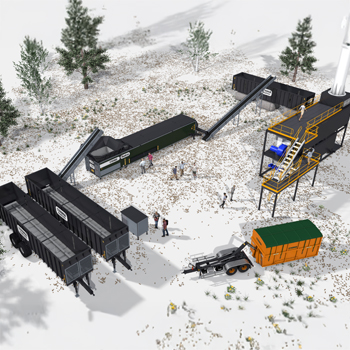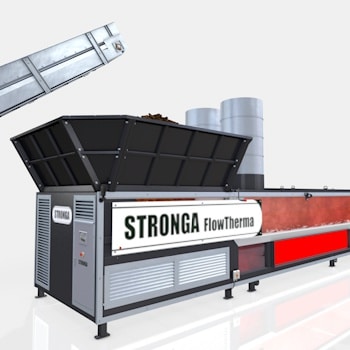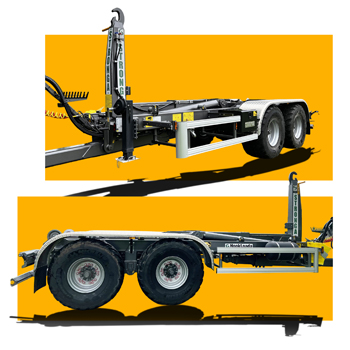A Recent History of Global Storm Events
The Met Office graph below is clear evidence that climate change is increasing the overall frequency of storms on a global basis. What’s more, there is also strong evidence that increasing sea temperatures are intensifying storms when they develop, particularly in tropical regions of the world, but also in the UK where storms have occurred with increasing severity in recent years. Such storms are causing widespread environmental destruction and a trail of severely damaged timber in their wake.
Forward-thinking forestry companies and tree surgeons are recognising this as a unique and potentially profitable opportunity for their business. Read on to learn how Stronga are providing premium solutions to serve the lucrative management of storm-damaged timber.
The graph below was created using data from the Met Office. Geophysical events include earthquakes, tsunamis and volcanic activity. Meteorological events include tropical storms, convective storms and local storms. Hydrological events included floods and mass movements. Climatological events include extreme temperature, drought and wildfires.

Opportunities for Forestry Entrepreneurs
When trees are subject to high speed winds from unfamiliar directions, the likelihood of damage is significantly increased. Once wind penetrates the outer ring of the tree, the inside of the tree - which is less weatherproof and more susceptible to damage – can become instable, weakening the integrity of the tree’s structure.
When heavy rainfall combines with high wind speeds, the ground surface becomes saturated, weakening the strength capacity of the tree’s roots. Together, high speed wind and heavy rainfall create the perfect recipe for felled and/or severely damaged trees.
At Stronga, we have heard from multiple clients about significant damage to small estate woodlands and grounds of large country houses. As storms subside, woodland damage needs to be cleared up and it is here where opportunities are created for forward-thinking forestry entrepreneurs to monetise chipped wood in the form of highly calorific energy using Stronga Drying Systems.

Managing Building Insurance Risk
In conjunction with the above, there is also the issue of client’s struggling to insure buildings unless they are able to prove that woodland grounds in close proximity are well-managed. In the unfortunate event of felled woodland causing property damage, insurance premiums increase exponentially whilst there are also troubles associated with repairing buildings, removing trees and dealing with insurance claims. Woodland owners have no choice but to improve their woodland management practices in order to avoid insurance penalties and other costly troubles.
As part of their management work, trees (diseased or not) in close proximity to buildings must be removed whilst broken bows and trees that have been moved by storms must be processed. The outcome from this management work is a greater supply of wood into the market; wood which can be dried by the client and utilised on-site as a free fuel.

Tree Pests & Diseases
In recent years, we've seen various reports of beetle damage in scots pine and larch plantations, making the timber unsuitable for processing in sawmills. This feeds more wood into the wood-fuel supply chain. Added to this, ash dieback is taking a heavy toll on the UK's ash tree population; worryingly, it is thought that up to 95% of ash trees will die over the coming years.
As these trees die, they become dangerous. Falling branches and whole trees add to the task of woodland management, also blocking roads and causing property damage. Part of this management involves strong replanting efforts to replace the UK’s stock of timber.

Free In-House Fuel
By separating the brash/arb chips and sorting chips into different stockpiles, clients have a fuel that may not be saleable in the market but can be utilised as a free, in-house fuel. Clients are increasingly taking advantage of this untaxed resource to create an energy source for the dryer - to subsequently create dry, saleable woodchip fuel, meeting woodchip specifications.
Due to high energy prices and overall energy inflation, we've seen strong demand of late, particularly from poultry houses, who have converted to biomass heating, which is often a year-round demand. There is a growing demand for clean, green, sustainably-produced woodchips. Investing in a Stronga dryer enables clients to produce a dry, useful fuel output through utilising a resource which would otherwise have been wasted.
It is worth noting that using lower quality fuel in any boiler system does create additional ash and a requirement for extra maintenance. You need to consider the boiler manufacturers requirements before adding the wood chip fuel.

Log Drying… On the Side
In addition to using the Stronga FlowDrya for drying brash and arb chips, clients often choose to add log drying container stations onto the side of the continuous dryer, using the same suitably-sized Heatex to dry both products at the same time. The combination of drying arb/brash and logs simultaneously optimises the business as it opens up to the log and woodchip markets – allowing the client to diversify their business operations.
Logs of course have a longer drying time and there are regulations coming into force about the burning of logs; you cannot, for example, burn wet wood as it is bad for the environment. This is increasing the demand for dried logs. We encourage clients to contact Stronga direct to discuss the potential for drying logs and woodchips in-situ. This is a tricky process and you need advice from the world’s most experience producer of biomass drying systems.

The Business Case for Drying Storm-Damaged Wood
When forestry companies are paid to remove wood from storm-damaged sites, they have the option of pursuing new business as a supplier of dry wood fuel. They can either (1) sell the wet chip at low prices or, (2) add significant value to their business by drying the timber and selling it into the local fuel market.
The graph below demonstrates how moisture content affects net calorific value of the wood fuel.

By engaging with Stronga specialists at an early stage, forestry entrepreneurs can be expertly guided through the process to avoid costly errors in designing biomass drying systems, scaling the amount and type of energy to the dryer, a critical part of the process. In some cases, through partnering with Stronga, forestry entrepreneurs with access to good volumes of wet chips have been able to significantly increase their income. Of course, there are added capex and operating costs, but when all costs are counted, the yield is still significantly positive.
Talk to Stronga. We would be happy to sit down with you and do the figures to work out your potential added income.

Wet & Dry Chip, Compared
To provide context for readers, 36m³ of dry softwood woodchip at 20% moisture weighs approximately 10 tonnes. The same 36m³ of 45% wet material weighs circa 16 tonnes. This gives you an idea of how much water is contained in wet chips, albeit, hidden from view. All of this water significantly reduces the calorific value of the woodchip, as well as causing other problems such as increased emissions, reduced efficiency, extra ash and increased boiler maintenance – not meeting the manufacturer’s requirements.
The woodchip fuel specification is becoming more regulated with schemes such as “wood-sure”; we advise forestry entrepreneurs thinking of extending their business into wood chip drying to partner with Stronga; the expert consultants in successful biomass drying projects.
Contact our technical today for more information. We look forward to hearing from you.
Email – sales@stronga.co.uk or call – 01992 519000



Share this post